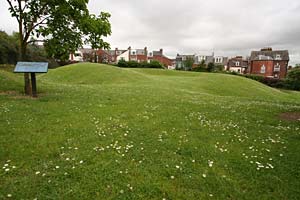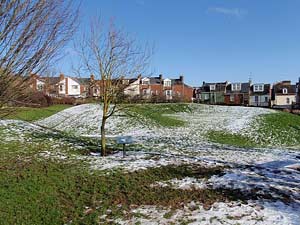
Danes Castle
Page updated 4th November 2009
In the Middle Ages it was known as New Castle, while by 1700, it had been named Danes Castle. An advert for let, of a field or pasture, of 4 acres, called Little Danes Castle appeared in the Flying Post in 1805, although a reference to Danes Castle can be found in the paper in 1801. The field was situated near the barracks, adjoining the new road (Howell Road) and in the occupation of William Vinnicombe, cow-keeper.
By 1838, the field adjoining the new reservoir called Danes Castle Field was again for sale, along with other parts of the estate of the late Mr Guppy. A smaller field of a little over one acre called Little Danes Castle Field was for sale in 1870, along with the Two "Starcombe" fields at the rear of about 9 acres and a recently built Cow Shippen.
The reservoir
The cholera outbreak of 1832 had proven to be a shock to the city council and steps were taken to acquire a wholesome water supply for the city. Pynes Water Works was opened in 1834 and on Monday 2 September 1833, work commenced on the new holding reservoir to be built at Danes Castle on land behind the prison. The reservoir, measuring 200 ft by 200ft (60m), and 17 ft (5m) deep was partly built over a circular structure that was thought to be the remains of a castle built by the Danes when they had Exeter under siege in 1003. It could hold 315,000 gallons of water, piped from Pynes.
The Water Corporation purchased 300 ft of elm timber and 32,000 four-inch land drains in 1879, and stored them at the reservoir at Danes Castle. The reservoir had a pumping engine which the Water Committee referred to in 1881, when it was noted that it had been improved and could produce one fifth more work for the same consumption of coal. In 1896, it was estimated that Danes Castle and Mary Pole reservoirs were supplying each citizen with 28 gallons of water per day.
By 1898, the filtration beds at the Danes Castle and Mary Pole reservoirs were inadequate, and additional land was acquired at Pynes from the Earl of Iddesleigh for larger filtration beds to be constructed. New, larger mains were installed in the city and the pumping engine removed from Danes Castle and installed, along with new turbines at Pynes, so that they could supply all the service reservoirs directly.
A castle uncovered
As already stated, it was known that there was a circular castle structure under the reservoir, which was misinterpreted as being Danish in origin. The reservoir was remodelled in 1993 and the castle uncovered and investigated by Exeter Museums Archaeological Field Unit. The castle was found to heve been built by King Stephen in 1136, as an earthen fortification when he had Baldwin de Redvers, in Rougemont Castle under a three month siege. The archaeologists discovered that foundations for a wooden gatehouse had been dug, but never built, probably because the three month siege had finished. After the dig the castle was landscaped, and it was registered as a Scheduled Monument.
 The ring mound of
Danes Castle.
The ring mound of
Danes Castle.
 The snow accentuates the shape of Danes Castle. Photo © Derek Harper.
Used under the Creative
Commons Licence
The snow accentuates the shape of Danes Castle. Photo © Derek Harper.
Used under the Creative
Commons Licence
│ Top of Page │